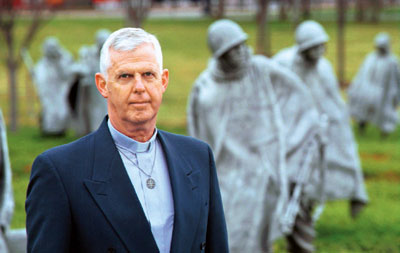The Influence of “Embedded Chaplains” Visible
in Our Soldiers
By Chaplain (Major General) Gaylord T. Gunhus,
U.S. Army Chief of Chaplains

WITH “EMBEDDED MEDIA,” you and I get satellite videophone images
from reporters diving from the whirl and boom of rocket-propelled
grenades and ducking the whistle of small-arms fire. We witness
up-close, split-second decisions about life and death under the
rubrics of “rules of engagement,” “casualty collection” and other
military jargon. Our nation and the world are witness to a war,
which brings us close to the life and actions of U.S. soldiers.
As brutal and deadly as is this war’s execution, our soldiers stand
at the most dangerous, volatile, complex and ambiguous edge of
humanity. This has been true of soldiers in the past, and I, for
one, am proud of the conduct and character of our soldiers in this
conflict. And in, with and under the lives of these soldiers (and
their waiting families), our Army has “embedded chaplains.”
I am
writing as a pastor, a patriotic American, and the chief of chaplains
for the U.S. Army. Presently, more than 480 chaplains
and 270 chaplain assistants are deployed in the Iraq war zone.
They stand beside
our soldiers as noncombatants representing hope grounded in faith.
Even amidst the differences in our society and around the world
about whether or not to use military force, soldiers fulfill their
duty by offering their loyal service on behalf of the nation. The
chaplains are present not to simply “add grace to the enterprise
of kings and princes” (Reinhold Neihbur), but chaplains are called
to bear witness to another reality. On a practical and immediate
level, chaplains lead worship, offer counseling and guidance, and
provide advice to Army leaders about the ethics, morals and morale
of soldiers. For me, this is a mantle of priestly, pastoral and
prophetic responsibility.
I have committed 37 years to ordained
ministry as a Lutheran pastor and as an Army chaplain. I have been
blessed by serving with soldiers and their leaders as they bear
the burden of combat and, like all of us, seek to give to the nation
and to the world a legacy of liberty, justice and peace. Personally,
I inherited the mantle of priestly, pastoral and prophetic roles
from my father, who served as a World War II chaplain. I wear a
mantle of responsibility when I wear the black and gold Army chaplain’s
stole that my dad used a generation ago and that he presented
to me.
Decisions about the use of military force are rightfully
the subject of prayerful deliberation in our churches, while the
authority of the decisions rests with our legitimately elected
civilian leadership. Soldiers carry out these decisions and, since
1775, chaplains bear witness to eternity among our men and women
in uniform.
The soldier and chaplain are each unique callings fulfilled
by those who respond to the call of the nation and to the call
of God. Even in the midst of the violence, fog and friction of
war, we look to the source of our hope and strength. In fact, especially
in the midst of armed conflict, soldiers and chaplains join the
nation and the whole world in seeking the guidance of God.
For all the pluses and minuses of the continuous, live reporting
of this war from the forward edge of the battle space, we can see
the courage, self-discipline, confidence, commitment and determination
of soldiers. The embedded reporters describe and broadcast what
they see. And I see the influence of the embedded chaplains, who
contribute to the character of our soldiers as they extend their
caring to young men and women who might not have the witness of
faith without these clergy in uniform.
I covet your prayers for peace and for the guardians of peace,
our soldiers on point for the nation.

Chaplain (Major General) G.T. Gunhus, chief of chaplains for the U.S. Army, is
responsible for the oversight of more than 2,300 active duty, National Guard
and reserve chaplains worldwide. During the war with Iraq, he has provided guidance
and policy for ministry to soldiers in combat. ?is includes assigning chaplains
to accompany officers to notify the families of soldiers killed in action, wounded,
missing in action or held as prisoners of war — and to minister to those families
in the aftermath. He attends the daily Operations and Intelligence updates with
senior Army leadership at the Pentagon and ends each briefing with prayer. Since
the war began, he has been on duty seven days a week, and expects to remain so
for several months to come. A member of the Seattle Pacific Class of 1962, Gunhus
was named the University’s Alumnus of the Year in 2001 for his service to countless
American soldiers in nearly four decades of service.
Back to the top
Back to Home
|
 |



From the President
Cultivating hope in the face of chaos is vital today. "This is the time
for a Christian university to dig down deep into its formative foundations… and
decide quite clearly what bread we have to offer,” says President Philip
Eaton.
Volumes of Volumes
SPU Library resources will top 22 million items in 2003. Starting this summer,
materials can be ordered online from the new “Orca” catalog through
the Orbis Cascade Alliance. [Campus]
Homecoming 2003: The Weekend
in Photos
From fast-paced hoops to class reunions where former classmates reconnected,
Homecoming 2003 was a picture-perfect weekend. See the action here. [Alumni]
The World of Teng Chiu
Seattle’s Frye Museum spotlights an art collection owned by an SPU professor
and her husband. Chinese artist Teng Chiu’s work has largely been forgotten,
but Joanna Poznanska is helping to reintroduce him to the West. [Faculty]
Playing With Joy
After an incredible season, the unbeaten Falcon women’s
basketball team lost the championship game but won the hearts
of the Puget Sound fans. [Athletics]
|
 |



